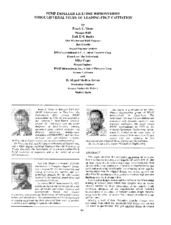| dc.description.abstract | This paper describes the successful application of cavitation flow visualization to redesign the impeller of an 8.5-MW (11,400 hp) high energy double suction single stage boiler feedpump. Dual purpose of the investigation was to develop an impeller/pump case combination showing significantly less cavitation at the impeller leading-edges than the original design, and realize specific rate objectives for meeting new duty points to eliminate high pressure throttling over the discharge valve. New impeller designs were tested in a full scale model test pump running at reduced speed, which was equipped with an acrylic viewing window for direct observation of the impeller blade cavitation. Elements of the experimental effort included determination of the effect of impeller (vane) design changes, along with the effect of suction box changes introduced at the splitter vanes. Initially, a total of four alternative impeller designs were considered, form which potentially best design was selected and tuned to specification. The new impeller design developed typically had sharp elliptic leading-edges to overcome the cavitation problem. Compared with the original design, in which impellers were replaced/repaired after less than one year of operation, the new impeller lifetime was calculated to be improved by at least a factor of eight, on the basis of cavitation bubble length. The NPSH required for the new design proved to be much better than for the original design, and, additionally the efficiency was established to be improved by one to two percent. Furthermore, a suction box splitter vane modification has led to less (cavitation) bubble activity in the eye area. | en |


